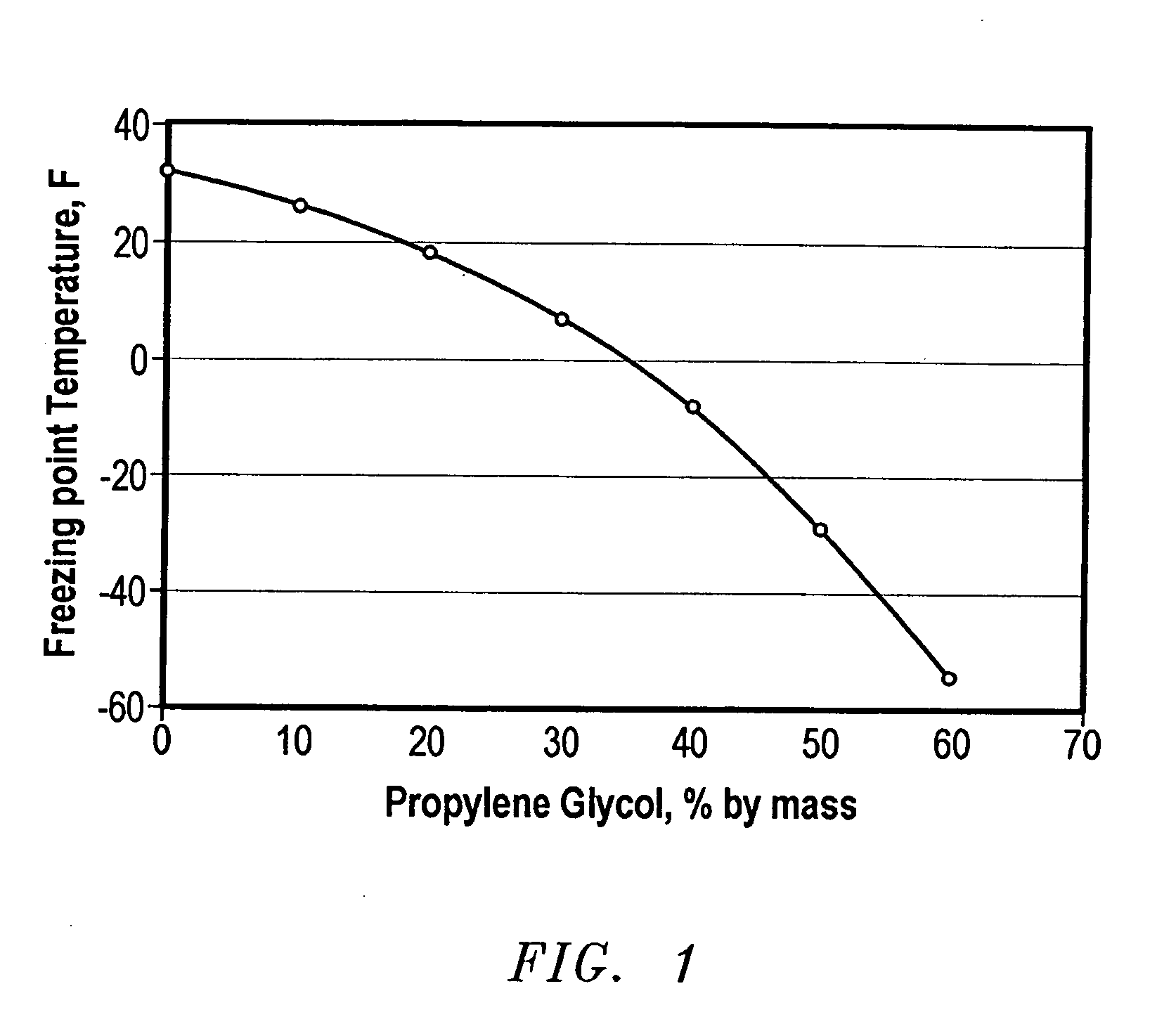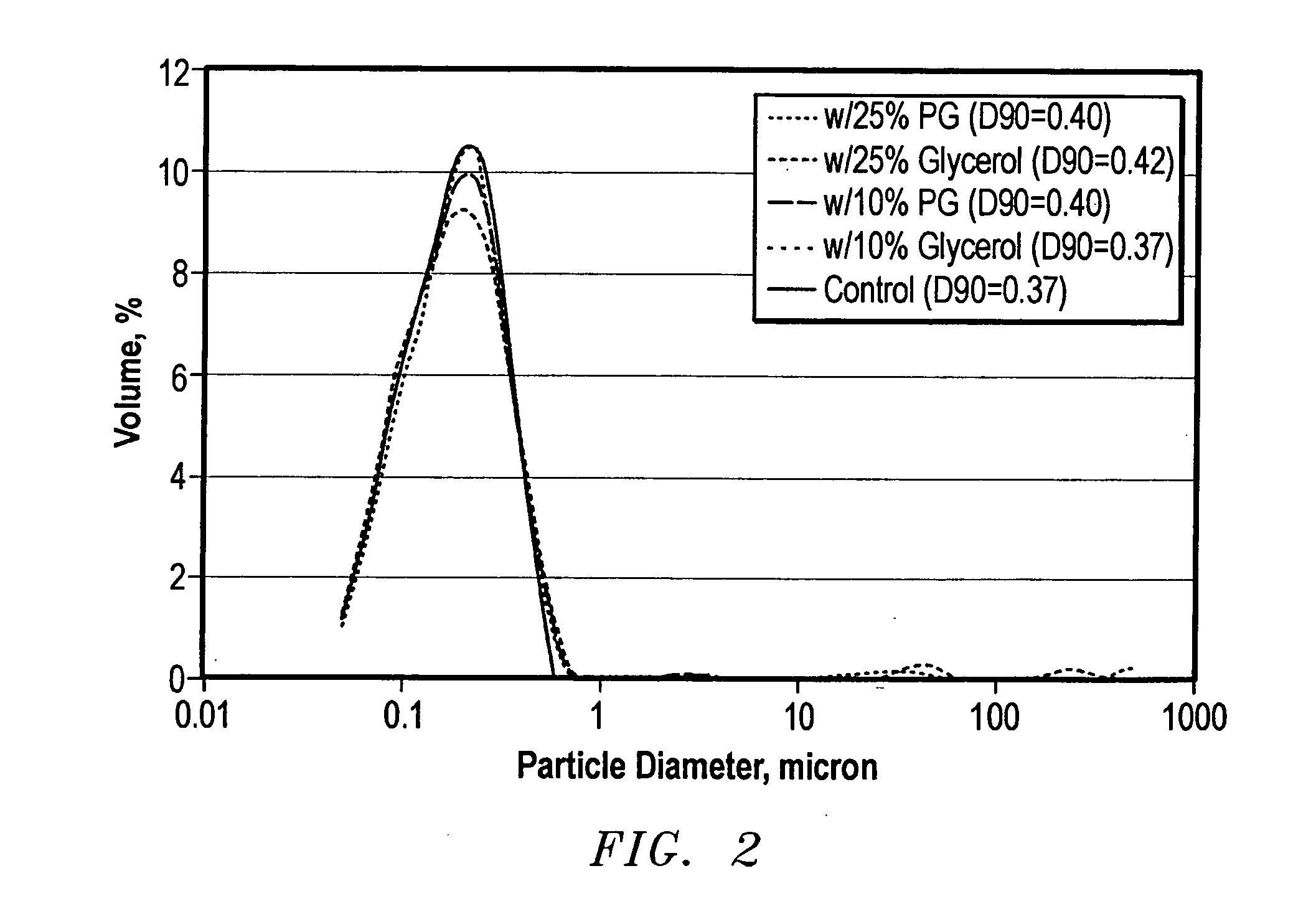Drilling fluid systems comprising latex particle(s)
a technology of latex particles and drilling fluid, which is applied in the direction of other chemical processes, chemistry apparatus and processes, and borehole/well accessories, etc., can solve the problem that latex particles exposed to water are susceptible to damag
- Summary
- Abstract
- Description
- Claims
- Application Information
AI Technical Summary
Benefits of technology
Problems solved by technology
Method used
Image
Examples
example 1
[0057] Table 1 shows the freezing point of propylene glycol based water solutions at different temperatures:
TABLE 1Freezing Point of Propylene Glycol based Water SolutionsPropylene Glycol Solution (% by mass)0102030405060Freezing(° F.)3226187−8−29−55Point(° C.)0−3−8−14−22−34−48Temperature
[0058] Table 2 shows the freezing point of glycerol based water solutions at different temperatures:
TABLE 2Freezing Point of Glycerol based Water SolutionsGlycerol Solution (% by mass)051015202530Freezing(° F.)32302825221812Point(° C.)0−1.3−2.3−3.7−5.5−7.9−11Temperature
[0059]FIG. 1 is a graph of the freezing point of propylene glycol based water solutions. Based on the foregoing Tables and FIG. 1, it was estimated that 25 wt. % propylene glycol would lower the freezing point of MAX-SHIELD® (100 g: 30 g sulfonated styrene-butadiene, 45 g water, and 25 g propylene glycol) from 0° C.(32° F.°) to about −19° C.(−2° F.). The resulting sample with 25 wt. % propylene glycol contained 35.7 wt. % propylen...
example 2
[0065] Five samples of MAX-SHIELD® containing propylene glycol or glycerol were subjected to multiple freeze-thaw cycles. The test results demonstrated that either compound lowered the freezing point and protected the latex from freeze damage. Glycols were more efficient and can be obtained at lower cost. Finally, MAX-SHIELD® samples blended with different concentrations of propylene glycol or ethylene glycol were evaluated after freezing for weeks in order to optimize the concentration of glycols used for freezing conditions.
[0066] Based on the tests, it was concluded that: the colloid particles of MAX-SHIELD® are damaged when frozen. Freezing has less effect on MAX-SHIELD® meeting the D90 size standards. Glycols and glycerol can be used to protect MAX-SHIELD® from freeze damage. Addition of propylene glycol, ethylene glycol or glycerol at concentrations up to 25% to MAX-SHIELD® generally will not change the original quality of MAX-SHIELD®. If MAX-SHIELD® does not meet the D90 siz...
example 3
[0075] Another test was conducted by storing the five samples at −25° C.(−13° F.). After 16 hours, all samples were frozen. The frozen samples were thawed in an oven at 37.8° C.(100° F.) for eight hours and the particle size distribution was analyzed. Finally, the samples were frozen and thawed again under the same conditions. FIG. 4 compares the changes in D50 (50% sample by volume is smaller than this diameter) and D90 (90% sample by volume is smaller than this diameter), before and after freezing. All samples blended with propylene glycol or glycerol had similar particle size distributions in fresh water before and after freezing. By contrast, the control sample was flocculated and its particle size distribution shifted to larger particles after freezing. This indicated that 10% propylene glycol or glycerol not only reduced the freezing point of the MAX-SHIELD® but also protected the colloidal latex particles from the effects of freezing. The same samples were evaluated in 1,438 ...
PUM
| Property | Measurement | Unit |
|---|---|---|
| Temperature | aaaaa | aaaaa |
| Fraction | aaaaa | aaaaa |
| Mass | aaaaa | aaaaa |
Abstract
Description
Claims
Application Information
 Login to View More
Login to View More - R&D
- Intellectual Property
- Life Sciences
- Materials
- Tech Scout
- Unparalleled Data Quality
- Higher Quality Content
- 60% Fewer Hallucinations
Browse by: Latest US Patents, China's latest patents, Technical Efficacy Thesaurus, Application Domain, Technology Topic, Popular Technical Reports.
© 2025 PatSnap. All rights reserved.Legal|Privacy policy|Modern Slavery Act Transparency Statement|Sitemap|About US| Contact US: help@patsnap.com



